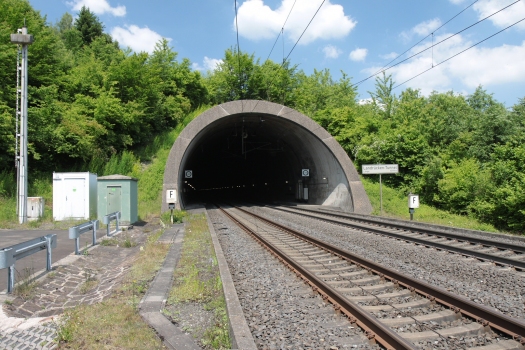General Information
| Name in local language: | Landrückentunnel |
|---|---|
| Beginning of works: | 28 September 1981 |
| Completion: | May 1988 |
| Status: | in use |
Project Type
| Structure: |
Tunnel |
|---|---|
| Function / usage: |
High-speed rail tunnel |
Location
| Location: |
Kalbach, Fulda (Kreis), Hesse, Germany Sinntal, Main-Kinzig-Kreis, Hesse, Germany |
|---|---|
| Part of: | |
| Coordinates: | 50° 24' 22.49" N 9° 39' 3.23" E |
| Coordinates: | 50° 18' 34.77" N 9° 39' 46.90" E |
Technical Information
Dimensions
| tunnel length | 10 780 m | |
| tunnel length | 10 779 m |
Design Loads
| design speed | 250 km/h |
Cost
| cost of construction | German Mark 320 700 000 |
Chronology
| 29 May 1988 | Opening. |
|---|
Excerpt from Wikipedia
The Landrücken Tunnel is a railway tunnel on the Hanover-Würzburg high-speed rail line. With a length of 10,779 metres (35,364 ft) it is the longest tunnel in Germany.
Geography
The tunnel is in east Hessen between the stations of Fulda and Würzburg. Between the northern tunnel entrance of Kalbach (50° 24′ 22″N, 9° 39′3″E) and the southern end at Mottgers (50° 18′35″N, 9° 39′47″E) it crosses the Landrücken range which forms the Rhein-Weser drainage divide dividing the river basins of the Fulda and Main.
Description of tunnel
The double-track Landrücken Tunnel was built using the New Austrian Tunnelling method working from the north portal, known as "Baulos Nord" and two side accesses ("Baulos Mitte" and "Baulos Süd"). In addition, three shafts were established for ventilation during tunnel boring.
The tunnel opened in 1988 with a total tunnel cross section of 100 to 110 square metres (1,100 to 1,200 sq ft) and a maximum 1.25% gradient. It surpassed the Kaiser-Wilhelm-Tunnel near Cochem as the longest railway tunnel in Germany.
Outside the north portal of the tunnel, at 380m altitude is the summit of the Hanover-Würzburg high-speed rail line.
Technical data
- length: 10,779 m (35,364 ft)
- year of opening: 1988
- tracks: two
- track separation: 4.70 m (15.4 ft)
- tunnel cross section area: 100 to 110 m² (1,100 to 1,200 sq ft)
- steepest gradient: 1.25%
- speed limit: 250 km/h (160 mph)
- equipment: Electrified, LZB signalling, "Zugfunk" radio, GSM-R, BOS-Funk, C-Netz (from 1992 to 2000), GSM900/1800 (T-mobile, Vodafone and Eplus since the middle of 2006), FM radio, wind direction measuring system, two emergency exits)
Accidents
The ICE power head 401 511 after the collision. The photo was taken three days later at the operational train station of Mottgers, after the powerhead had been recovered.
On April 26, 2008, ICE train 885 was on its way from Hamburg to Munich with 170 people on board. At 9:05pm, it collided with a herd of sheep that had strayed into the tunnel. The train derailed at 215 kilometres per hour (134 mph) inside the tunnel. 25 people were injured, 12 of the 14 cars were derailed.
Distelrasen-Tunnel
A few kilometers west of the Landrücken Tunnel, the Distelrasen-Tunnel built in 1914, near Schlüchtern-Elm on the Kinzig Valley Railway, was the first railway to traverse the Landrücken drainage divide.
Text imported from Wikipedia article "Landrücken Tunnel" and modified on July 23, 2019 according to the CC-BY-SA 4.0 International license.
Participants
Relevant Web Sites
- About this
data sheet - Structure-ID
20007184 - Published on:
09/12/2002 - Last updated on:
28/05/2021






